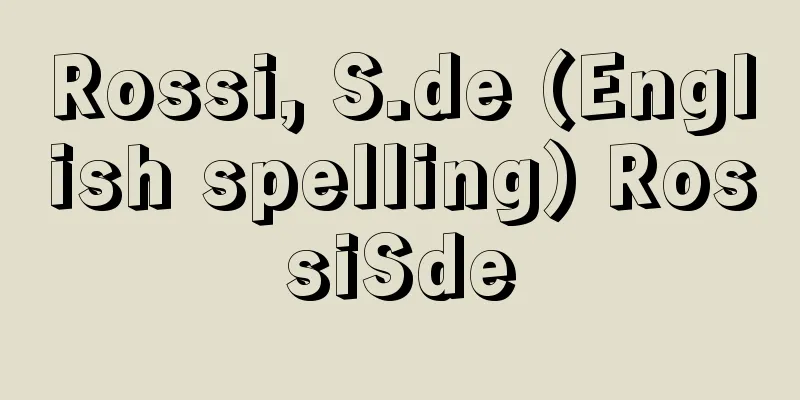Gifu Castle

|
A mountain castle ( Yamajiro ) located in Gifu City, Gifu Prefecture. It is a designated historic site by the city. It is one of the "100 Great Castles of Japan" selected by the Japan Castle Foundation. During the Sengoku period, it was the residence of three generations of the Saito clan, Dosan, Yoshitatsu, and Tatsuoki, and was also the residence of Oda Nobunaga, who conquered Mino, for a time. The castle was located on Kinka Mountain (328.9m above sea level, formerly known as Inabayama, and also called Iguchiyama in the past), an independent peak on the banks of the Nagara River, and was called Inabayama Castle until Oda Nobunaga renamed it Gifu Castle. It is said that the beginning of Gifu Castle was when Nikaido Masayoshi built a fort on Inabayama in 1201 (Kennin 1) at the beginning of the Kamakura period. This fort was later abandoned, but in the mid-15th century, Saito Toshinaga, the deputy governor of Mino, restored the former fortress site and used it as his residence. In 1525 (Oei 5), Saito retainers Nagai Nagahiro and Nagai Shinzaemon-no-jo rebelled and attacked Inabayama Castle, which came under the control of the Nagai clan, with Shinzaemon-no-jo becoming the castle's lord. Shinzaemon-no-jo's son was Nagai Shinkuro Norihide (later Saito Dosan). Dosan inherited the family headship and became the lord of Inabayama Castle in 1533 (Tenbun 2), was adopted by the Saito clan, changed his name to Saito Toshimasa, and succeeded as the shugodai of Mino Province. Dosan built a castle on the top of Mount Kinka in 1539 (Tenbun 8), and in 1541 (Tenbun 10) expelled the shugo Toki Yorifusa, effectively seizing power as a feudal lord. Toshimasa (Dosan) continued to live in Inabayama Castle, and the castle became the center of Mino. In 1544 (Tenbun 13), Toshimasa handed over the family headship to his eldest son, Saito Yoshitatsu, shaved his head, and took the name Dosan. Dosan continued to hold real power thereafter, but the conflict with Yoshitatsu gradually grew, and in 1556 (Koji 2) the father and son fought the Battle of Nagaragawa, in which Dosan was killed by Yoshitatsu. Yoshitatsu then came into conflict with Owari's Oda Nobunaga, who had invaded eastern Mino, and engaged in repeated armed clashes, but in 1561 (Eiroku 4), Yoshitatsu suddenly died, and Saito Tatsuoki, at the age of 13, inherited the family headship and became the lord of the castle. That year, Oda Nobunaga won the Battle of Jushijo and attacked Inabayama Castle, but was defeated. In 1567 (Eiroku 10), Nobunaga, with the help of the three men of western Mino, invaded the area around Inabayama Castle, leading to the Battle of Inabayama Castle. During this battle, Tatsuoki abandoned the castle and fled to Ise Nagashima, and the Oda clan occupied Inabayama Castle. Nobunaga moved his castle from Komakiyama Castle (Komaki City, Aichi Prefecture) to Inabayama Castle, renamed Inabayama Castle and the castle town Gifu, and used this castle as his base to unify the country. In 1576 (Tensho 4), Nobunaga built Azuchi Castle and moved there, and handed over Gifu Castle, the two provinces of Mino and Owari, and the headship of the Oda clan to his eldest son, Nobutada. Nobutada further improved and renovated Gifu Castle. In June 1582 (Tensho 10), Nobunaga and his eldest son, Nobutada, who was the lord of Gifu Castle, died in the Honnoji Incident. Shortly after, Saito Toshitaka, a retainer of Nobutada, took over Gifu Castle, but after Akechi Mitsuhide was defeated by Hashiba Hideyoshi (later Toyotomi Hideyoshi), he surrendered to Oda Nobutaka (Nobunaga's third son). At the Kiyosu Conference, it was decided that Nobutaka would inherit Mino Province and Gifu Castle. Nobutaka was in conflict with Hideyoshi and revolted twice, but was defeated by Hideyoshi and forced to commit seppuku in 1583 (Tensho 11). In the same year, Ikeda Tsuneoki entered Ogaki Castle (Ogaki City), and Tsuneoki's eldest son, Motosuke, entered Gifu Castle. Furthermore, in 1584 (Tensho 12), when Ikeda Tsuneoki and Motosuke were killed in the Battle of Komaki and Nagakute, Tsuneoki's second son, Ikeda Terumasa, entered the castle and made it his residence. In 1591 (Tensho 19), when Terumasa was transferred, Oda Hidenobu (Nobunaga's eldest grandson and Nobutada's eldest son) entered Gifu Castle as the lord of Gifu with a fief of 130,000 koku. In the Battle of Sekigahara in 1600 (Keicho 5), Nobuhide sided with the Western Army in response to Ishida Mitsunari's uprising. As a result, Gifu Castle, where Hidenobu had barricaded himself, was attacked by Fukushima Masanori and Ikeda Terumasa on the eve of the Battle of Sekigahara and fell to them. In 1601 (Keicho 6), the year after the battle, Tokugawa Ieyasu decided to abandon Gifu Castle. Ieyasu ordered Honda Tadakatsu and Okudaira Nobumasa to build a new castle, Kano Castle (Gifu City), and it is said that the castle tower and turrets of Gifu Castle were moved to Kano Castle at that time. In 1910 (Meiji 43), a restored castle tower was constructed on the site of Gifu Castle, and in 1956 (Showa 31), a three-story, four-storey castle tower was built using reinforced concrete (the interior of the replica castle tower is now a museum), and in 1975 (Showa 50), a corner tower (Gifu Castle Museum) was completed. Currently, the castle site has been developed as Gifu Park. In the park, you can see remains of the kuruwa ( circular enclosure), stone walls, earthworks, wells, and replica structures of the castle tower, Kanbokumon (crowning gate), and corner tower. At the foot of the mountain, there is the remains of Nobunaga's residence, where the Kanbokumon (crowning gate) and earthworks have been restored, and there is also a history museum nearby. Take a bus from JR Gifu Station on the Tokaido Main Line or Meitetsu Gifu Station on the Meitetsu Nagoya Main Line to the Gifu Park History Museum stop, then transfer to the Kinkasan Ropeway for about 3 minutes to Kinkasancho Station, and walk for about 8 minutes (to the castle tower at the top of Kinkasan). ◇In the past, it was called Inabayama Castle. Source: Kodansha Encyclopedia of Japanese Castles Information |
|
岐阜県岐阜市にあった山城(やまじろ)。同市指定史跡。日本城郭協会選定による「日本100名城」の一つ。戦国時代、道三・義龍・龍興の斎藤氏3代が居城とし、美濃を制圧した織田信長が一時期居城とした城である。長良川河畔の独立峰、金華山(標高328.9m、旧名稲葉山、古くは井口山ともよばれた)にあった城郭で、織田信長が岐阜城と改名するまでは稲葉山城と呼ばれていた。鎌倉時代初めの1201年(建仁1)に二階堂行政が稲葉山に砦を築いたのが岐阜城の始まりといわれる。この砦はその後廃棄されたが、15世紀の中頃、美濃の守護代斎藤利永が、かつての城塞跡を修復して居城とした。1525年(大永5)、斎藤氏家臣の長井長弘と長井新左衛門尉が謀叛を起こして稲葉山城を攻撃し、稲葉山城は長井氏の支配下に置かれ、新左衛門尉が城主となった。新左衛門尉の子が長井新九郎規秀(後の斎藤道三)である。道三は1533年(天文2)に家督を継いで稲葉山城の城主となり、斎藤氏の養子となって斎藤利政と名前を改め、美濃国の守護代を継いだ。道三は1539年(天文8)、金華山山頂に城の建設を行い、1541年(天文10)には守護の土岐頼芸を追放して大名としての実質的な権力を掌握した。利政(道三)はその後も稲葉山城を居城としたため、この城は美濃の中心となった。1544年(天文13)、利政は家督を嫡男の斎藤義龍に譲り、剃髪して道三と号した。道三はその後も実権を掌握していたが、しだいに義龍との対立が大きくなり、1556年(弘治2)には父子の間に長良川の戦いが起こり、道三は義龍に討ち取られた。義龍はその後、東美濃に侵攻した尾張の織田信長と対立し武力衝突を繰り返すが、1561年(永禄4)に義龍は急死し、斎藤龍興が13歳で家督を継ぎ、城主となった。この年、十四条の戦いに勝利した織田信長は稲葉山城を攻めたが敗退している。1567年(永禄10)、信長は西美濃三人衆の内応により稲葉山城下に侵攻して稲葉山城の戦いが行われた。この戦いで、龍興は城を捨てて伊勢長島に逃れ、織田氏が稲葉山城を占拠した。信長は居城を小牧山城(愛知県小牧市)から稲葉山城に移して、稲葉山城と城下を岐阜と改め、この城を拠点に天下統一に乗り出した。1576年(天正4)、安土城を築いて居城を移した信長は嫡子の信忠に岐阜城と美濃・尾張の2ヵ国、および織田家の家督を譲った。信忠は岐阜城のさらなる整備・改修を行った。1582年(天正10)6月、信長と岐阜城主の嫡男信忠は本能寺の変で死去した。その直後、信忠家臣の斎藤利堯が岐阜城を乗っ取ったが、明智光秀が羽柴秀吉(のちの豊臣秀吉)に敗れると織田信孝(信長三男)に降伏。清洲会議により信孝が美濃国と岐阜城を相続することになった。信孝は秀吉と対立し、2度にわたって蜂起したが秀吉に敗れ、1583年(天正11)に切腹させられた。同年、池田恒興が大垣城(大垣市)に入城すると、恒興の嫡男元助が岐阜城に入城した。さらに1584年(天正12)、小牧・長久手の戦いで池田恒興と元助が討ち死にすると、恒興の二男池田輝政が入城して居城とした。1591年(天正19)、輝政が転封すると、織田秀信(信長の嫡孫、信忠の嫡男)が岐阜13万石の領主として岐阜城に入城した。1600年(慶長5)の関ヶ原の戦いで、信秀は石田三成の挙兵に呼応して西軍に与した。このため、秀信が立て籠もった岐阜城は、関ヶ原の戦い前夜に福島正則や池田輝政らに攻められて落城した。戦いの翌年の1601年(慶長6)、徳川家康は岐阜城の廃城を決めた。家康は本多忠勝や奥平信昌に命じて、新たに加納城(岐阜市)を築かせたが、その際、岐阜城の天守や櫓などは加納城に移されたといわれている。1910年(明治43)、岐阜城跡に復興天守が建設され、1956年(昭和31)には鉄筋コンクリート造の3層4階建ての天守に立て替えられ(模擬天守の内部は資料館になっている)、1975年(昭和50)には隅櫓(すみやぐら)(岐阜城資料館)が完成している。現在、城跡は岐阜公園として整備されている。園内には曲輪(くるわ)・石垣・土塁・井戸などの遺構とともに、天守閣・冠木門・隅櫓の模擬建造物がある。また、山麓には信長の居館跡があり冠木門と土塁が復元されているほか、近くに歴史博物館がある。JR東海道本線岐阜駅、あるいは名鉄名古屋本線名鉄岐阜駅からバスで岐阜公園・歴史博物館前下車、金華山ロープウェーに乗り換え約3分で金華山頂駅下車、徒歩約8分(金華山頂の天守まで)。◇古くは稲葉山城とよばれた。
出典 講談社日本の城がわかる事典について 情報 |
Recommend
Calligraphy meeting (English spelling) shū huì
During the Song and Yuan dynasties in China, with ...
Goodyera foliosa (English spelling) Goodyerafoliosa
… [Ken Inoue]. … *Some of the terminology that me...
Aluminum alkyl
A general term for compounds in which aluminum is ...
Ookurigani - Ookurigani
→ Hairy crab Source : Heibonsha Encyclopedia About...
Enhadra quaesita heguraensis (English spelling) Enhadraquaesitaheguraensis
…[Tadashige Nabe]. . … *Some of the terminology t...
The Law of Compassion for Living Creatures
(1) The extension of the horses to the stables of...
Oshi people - Oshi tribe
…Famous Sarmatian treasures include the artifacts...
Stabilization paper - Anti-static paper
... In color photographic paper (color paper), th...
Dreaming Boy - Yumemikozo
The protagonist of a fairy tale. A boy who had a f...
Ceriagrion melanurum
... Mortonagrion hirosei (discovered in Hinuma, I...
Unfair trade practices
A type of business conduct prohibited by the Antim...
Wilhelm Tell
Schiller's last completed verse play. Written ...
Diazo type
This is a photographic method that utilizes the f...
Ding Wèi (English spelling)
966‐1037 A prime minister during the Zhenzong peri...
Ramírez, F.
… Research into Mesoamerican culture began with r...









